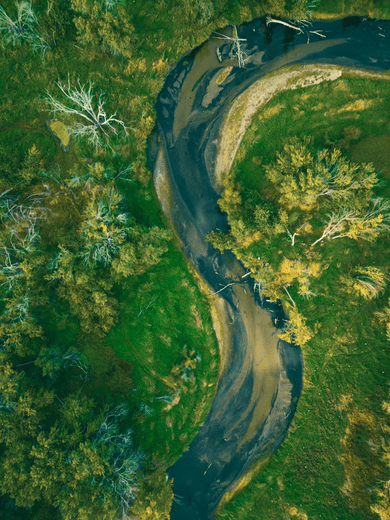Water:
Dating & Isotopic Analyses
 Water’s continuous movement and flow of water across landscapes contribute to and provide important clues into the intricacies of biogeochemical cycles at various spatial and temporal scales. The analyses of various isotopes in water – including Boron ( δ11B ), Strontium (87Sr/86Sr), and Lead (208Pb/206Pb) – are vital in such studies.
Water’s continuous movement and flow of water across landscapes contribute to and provide important clues into the intricacies of biogeochemical cycles at various spatial and temporal scales. The analyses of various isotopes in water – including Boron ( δ11B ), Strontium (87Sr/86Sr), and Lead (208Pb/206Pb) – are vital in such studies.
The global boron cycle interacts with many spheres, cycling through the atmosphere, biosphere, hydrosphere, and lithosphere. Natural sources include dust transportation through the atmosphere, rock weathering into water bodies, volcanic eruptions, and forest fires. This cycle is also influenced by anthropogenic boron sources, including biomass/charcoal emissions, mining, manufacture/use of industrial products, surface runoff from agriculture, and seepage from landfills, sometimes resulting in widespread contamination. Elevated boron concentrations pose the threat of toxicity and need to be mitigated. These natural and anthropogenic boron inputs are cycled through the hydrosphere and have distinct δ11B isotopic signatures – allowing one to reconstruct sources and transportation of water and different contaminants therein. For example, high boron concentrations in thermal and freshwater in Greece were analyzed by Dotsika et al. (2006) to identify the likely source. The authors compared the water boron concentrations and isotopes (δ11B) with likely anthropogenic and natural sources, finding that the high levels were due to natural processes, including geothermal activity and/or saltwater intrusions present within the region. Importantly, this demonstrates that lowering these high background levels is impossible since they are not anthropogenic – rather, this local anomaly must be solved by mixing with low-concentration waters.
In addition to δ11B,87Sr/86Sr and 208Pb/206Pb within water are very important in a variety of environmental chemistry studies – often used in provenance studies because different landscapes have specific 87Sr/86Sr and 208Pb/206Pb signatures in the bedrock, which gets transferred to the overlaying plant material and water bodies. Additionally, Strontium in particular has distinguishable 87Sr/86Sr signatures associated with common contaminants.
While Strontium and Boron alone can each be powerful tools in geochemical fingerprinting of contamination, in some cases the potential contamination sources within a landscape can have overlapping isotopic signatures. In such circumstances, the dual isotope approach of using 87Sr/86Sr and δ11B together can narrow down the potential contamination. For example, in a study by Pennisi et al. (2006) the authors analyzed the contamination of a drinking water aquifer in Tuscany to parameterize the source. Based on δ11B evidence from aquifer water, the researchers believed the contamination arose from a boric acid manufacturing plant. However, this could only be confirmed by tracking the movement of the aquifer water using 87Sr/86Sr to confirm the interaction of this drinking water with the manufacturing plant.
In addition to understanding the contaminants, movement, and origin of fresh and groundwater, radiocarbon dating (14C) also has powerful applications for groundwater using either the dissolved organic carbon (DOC) or dissolved inorganic carbon (DIC) portion. 14C analysis of groundwater is useful in assessing the flow rate by dating water at sequential points along a flowpath over time. In addition to assessing flow, continuous measurements across multiple years can be used to assess if the water is progressively changing in age, which signals the potential over-pumping of aquifers. Finally, 14C dating can be used to estimate when the water last interacted with the atmosphere by matching the level of 14C in the water to different levels at atmospheric 14C over time.
The quantity of water required for dating and isotopic analysis varies as follows:
| Analysis Type | Sample Quantity | Recommendations |
| Radiocarbon (14C) Dating | DOC: 1L Single-use Amber Glass or Brown Nalgene (HDPE) bottles DIC: 250mL – 1L |
Dissolved Organic Carbon (DOC) in Freshwater: The laboratory will only analyze filtered samples (0.7 µm or less) with a minimum DOC concentration of 5.0 mg C/L (5.0 ppm). Bottle must be pre-acid washed with 10% HCl (aq) and rinsed with DI water to a neutral pH. Fill the bottle all the way to the top, you may leave a small space at the top (keep the neck of the bottle empty) to allow for any necessary expansion during shipment.
Dissolved Inorganic Carbon (DIC) in Groundwater: Do not add any chemicals to the bottle prior or after collection. Fill the bottle all the way to the top, you may leave a small space at the top (keep the neck of the bottle empty) to allow for any necessary expansion during shipment. |
| Boron (δ11B) Isotopes | 100mg in a small-neck plastic bottle |
Do not add any chemicals to the water, do not acidify the water. Fill the bottle all the way to the top, you may leave a small space at the top (keep the neck of the bottle empty) to allow for any necessary expansion during shipment. Only samples with a concentration of 10 ppb or greater will be selected for analysis. |
| Strontium (87Sr/86Sr) Isotopes | 125mg in a small-neck plastic bottle |
Do not add any chemicals to the water, do not acidify the water. Fill the bottle all the way to the top, you may leave a small space at the top (keep the neck of the bottle empty) to allow for any necessary expansion during shipment. |
| Lead (Pb) Isotopes |
Contact us today to discuss your water samples!
Image: https://www.pexels.com/photo/dry-river-in-a-valley-19348637/
References
Pennisi, M., Gonfiantini, R., Grassi, S. and Squarci, P., 2006. The utilization of boron and strontium isotopes for the assessment of boron contamination of the Cecina River alluvial aquifer (central-western Tuscany, Italy). Applied Geochemistry, 21(4), pp.643-655.
Dotsika, E., Poutoukis, D., Michelot, J.L. and Kloppmann, W., 2006. Stable isotope and chloride, boron study for tracing sources of boron contamination in groundwater: boron contents in fresh and thermal water in different areas in Greece. Water, air, and soil pollution, 174, pp.19-32.
